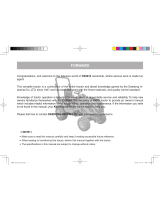
OPERATION 6
15
6.5 TO DRIVE VEHICLE ________________________________________________________
Read and follow all safety notes contained in this manual
when driving vehicle. Refer to Section 6.3 for general
operating instructions. When operating in reverse look
behind you to ensure you have a clear path.
Important: If this truck is driven on public roads, it must
comply with federal, state and local ordinances. Contact
local authorities for regulations and equipment
requirements.
Manual Transmission:
1. Disengage remove hydraulic system and fully lower
the truck bed when driving to and from the area of
operation.
2. Apply service brake and disengage parking brake.
3. The gear selector has an "H" pattern as shown in
(there is also a shift-pattern design molded into the
top of the gear selector handle).
4. With the clutch pedal fully depressed, select the
appropriate gear (forward or reverse), release the
clutch pedal slowly while depressing the throttle
pedal. Refer to Section 6.6 for proper gear based
on desired engine rpm and ground speed. Always
start in 1st or second gear and shift into higher
gears as ground speed increases.
Do not drive faster than 5-6 mph (8 to 10 kph), or
drive long distances in reverse.
NOTE: As you release the clutch pedal you will notice
after the pedal has been partially released the vehicle will
begin to move. When the vehicle begins to move,
depress the throttle a little more and at the same time
keep releasing the clutch pedal. DO NOT drive with the
clutch pedal partially depressed.
5. When the vehicle gains enough speed, depress the
clutch pedal and shift to the next higher gear and so
on. When you shift gears remember that as you
push in the clutch you need to release the throttle
pedal. DO NOT push in the accelerator at the same
time you are pushing in the clutch while shifting to a
higher or a lower gear (downshifting).
6. You can down-shift from fourth to third and from
third to second and so on while the vehicle is
moving and the engine's speed is decreasing.
If the engine rpm and/or the vehicle speed are not
decreased sufficiently and you try to down shift, it is
possible to damage the transmission. DO NOT force
the gear selector to the next lower gear. Slow the
engine and vehicle speed until the gear selector can
be shifted properly.
NOTE: Only downshift if the vehicle is at a complete stop
or if the engine's speed is decreasing.
Remember, before shifting to any gear you have to
depress the clutch pedal before you shift to that
particular gear.
Automatic Transmission:
1. Disengage remote hydraulic system and fully lower
the truck bed when driving to and from the area of
operation.
2. Apply service brake and disengage parking brake.
3. Depress the button on shifter handle and select the
appropriate gear (forward or reverse). Refer to
Section 6.6 for proper gear based on desired
engine rpm and ground speed.
Do not drive faster than 5-6 mph (8 to 10 kph), or
drive long distances in reverse.
4. Release the service brake and slowly depress the
accelerator pedal to reach the desired speed.
NOTE: Accelerating the engine with the transmission in
gear (Reverse (R), Drive (D), Second (2) or Low (L))
while holding the vehicle with the service brake or
parking brake may cause transmission damage.
5. Bring the vehicle to a full and complete stop before
moving the gear selector lever to Park (P) or
shiftting from Drive (D) to Reverse (R) or shifting
from Reverse (R) to Drive (D).
6. When driving forward down a steep incline or long
grade, the transmission may be shifted to a lower
gear (Second (2) or Low (L)) to help slow the
vehicle. Excessive or prolonged use of brakes can
cause loss of braking efficiency or loss of braking
function due to overheating and can cause
premature brake wear.
CAUTION
To prevent tipping or loss of control, travel at reduced
speed when making turns.
!
CAUTION
Vehicle engine speed should NEVER be faster than
idle speed when shifting from park or neutral into
Reverse (R), Drive (D), Second (2) or Low (L), as
sudden vehicle movement may occur.
!





















